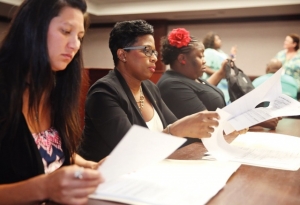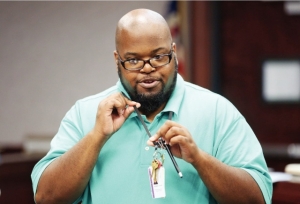In their corner: Guardian ad Litem program needs more volunteers
By John Joyce
Published in News on July 12, 2015 1:50 AM

News-Argus/MELISSA KEY
Joan Williams, left, Sharon Mims and Tekisha Graham look through some options for their first case after being sworn in as new Guardian ad Litem volunteers at the Wayne County Courthouse last week.

News-Argus/MELISSA KEY
Program administrators train a new group of volunteers for the program.
The Guardian ad Litem program maintains a staff of 137 -- only 137 for the entire state.
Everything else is done by volunteers.
But despite a seemingly small team, the program -- one that advocates for children who either do not have parents or who have been removed from their parents' care -- still managed to serve more than 15,000 young people in 2014.
This year, more than 1,500 children do not have guardians.
"That is just unacceptable," district administrator Colleen Kosinski said.
Ms. Kosinski oversees the Guardian ad Litem Program Judicial District 8 & 3A. With 140 volunteers serving 240 children in three counties -- Wayne, Lenoir and Pitt -- the odds lean toward some children getting less attention than they deserve.
"It is really wonderful when you know you have impacted a child's life. And I know that without our program children would fall through the cracks," Mrs. Kosinski said.
The children she and her volunteers serve have usually endured the worst aspects of life -- suffering neglect, abuse and sexual assault; witnessing everything from domestic violence to rape.
"When you see a shell of a child ... there are no emotions," volunteer Annette Phelps said. "There is basically no life in the eyes of that child."
Mrs. Phelps will soon celebrate her one year anniversary as a Guardian ad Litem volunteer. In that time, she has encountered several children dealing with a host of difficult circumstances.
Sometimes, she said, they get better. But more often than not, they face a long road.
"They don't know proper interaction, like between siblings. They don't know what is appropriate, what is not appropriate. And some of the children that I've had, they didn't interact with each other at all," she said.
Stacie Parish has been volunteering with the program for two years -- and also helps with the training curriculum that prepares new volunteers for what they will encounter serving as the bridge between the children and the courts.
She and Emily Peacock, who estimates her time as a volunteer somewhere between 25 and 30 years, are both currently assigned children who have been in the system for years. It is not ideal, Mrs. Parish said, but it does happen.
"The Department of Social Services wants permanency within a year. That is the goal," Mrs. Peacock said.
One of "her kids" has been in the system three years.
And Mrs. Parish recently worked with a child who had been in the system for nearly a decade.
"It is not a perfect system. A lot of times they are moved from one foster home to another," she said.
Mrs. Peacock has two teenagers that, together, have been placed in nine foster homes.
Each of the women refer to those they serve as if they were their own.
"They're our kids. They are our kids," Mrs. Parish said.
"You become emotionally attached," Mrs. Phelps added.
"You fight for them like they are your own," Mrs. Parish then said. "They are our kids."
The fight can sometimes be long and might even pit one agency against another.
But Mrs. Parish said that through fighting with the courts, the child's school and, sometimes, with the parents, a bond is forged between the volunteer and the child that lasts for long after the day the child being is placed in a permanent home.
It is a process that usually begins after a trauma has been witnessed or, more often, endured.
"Usually what happens is there is some incident that gets reported to DSS. That is really how it gets started," Mrs. Peacock said. "As GALs, we can't become involved until we are actually petitioned by the court."
Once a case has been reported, DSS conducts an investigation. It does its best to work with the family in question to make arrangements for the child to be put into protective custody -- whether they end up with a family member or a friend -- outside of the home where the substandard conditions exist, Mrs. Peacock said.
During that time, DSS will work with the family to get the parents back on track.
And if they can't come to any conclusion that they can make work, DSS petitions the court for a Guardian ad Litem to become involved.
From there, it is a matter of the volunteer piecing together a puzzle of information to determine the specific needs of the child whose case they have been assigned.
Mrs. Phelps described the steps a volunteer takes when a new case comes across his or her desk.
The more difficult the conditions the child is facing, the more difficulty the volunteer might have in being able to handle what the case will entail.
"Some people may not want to take a particular case if it too closely resembles their own life experience," Mrs. Phelps said. "Some volunteers might like to work with younger children as opposed to teenagers. Ages, the amount of family members or siblings, so you get to chose whether you are willing to take the case and if you are then you get the packet."
The packet includes the child's pedigree and any court documents, investigation reports or statements made regarding the child.
The volunteer studies the packet and decides whether or not the case is a good fit.
"And then you just start investigating your case," she said.
First comes the meeting with the child, and then it is on to the teachers, parents, and various other adults involved in the child's life.
"Whatever order you'd like -- the social worker, the teacher, the doctor," Mrs. Parish said.
Once the volunteer has met with all of the adults who interact routinely with the child -- and they have visited and spoken with the child -- the volunteer compiles a report for the court.
The judge will then consider the needs of the child and make a determination where to place him or her.
Often the outcome is that the family has done what it needed to do to correct the situation and the child is returned to their parents.
And although that isn't always the case, when it does work out that way the volunteers each agreed there is no more rewarding a feeling.
"As volunteers, obviously we don't get paid, but when the case, when something goes really good for these kids, it is such a big win," Mrs. Parish said. "It feels like the biggest paycheck of your life."
The Guardian ad Litem program is actively seeking volunteers. Training includes a take-home manual to study and a 30-hour, hands-on training curriculum.
A new online training option called Flex training is being offered on a test-case basis.
For more information on the Guardian ad Litem program, or to volunteer, contact Colleen Kosinski or Sebastian Ratliff at 919-722-6300.
